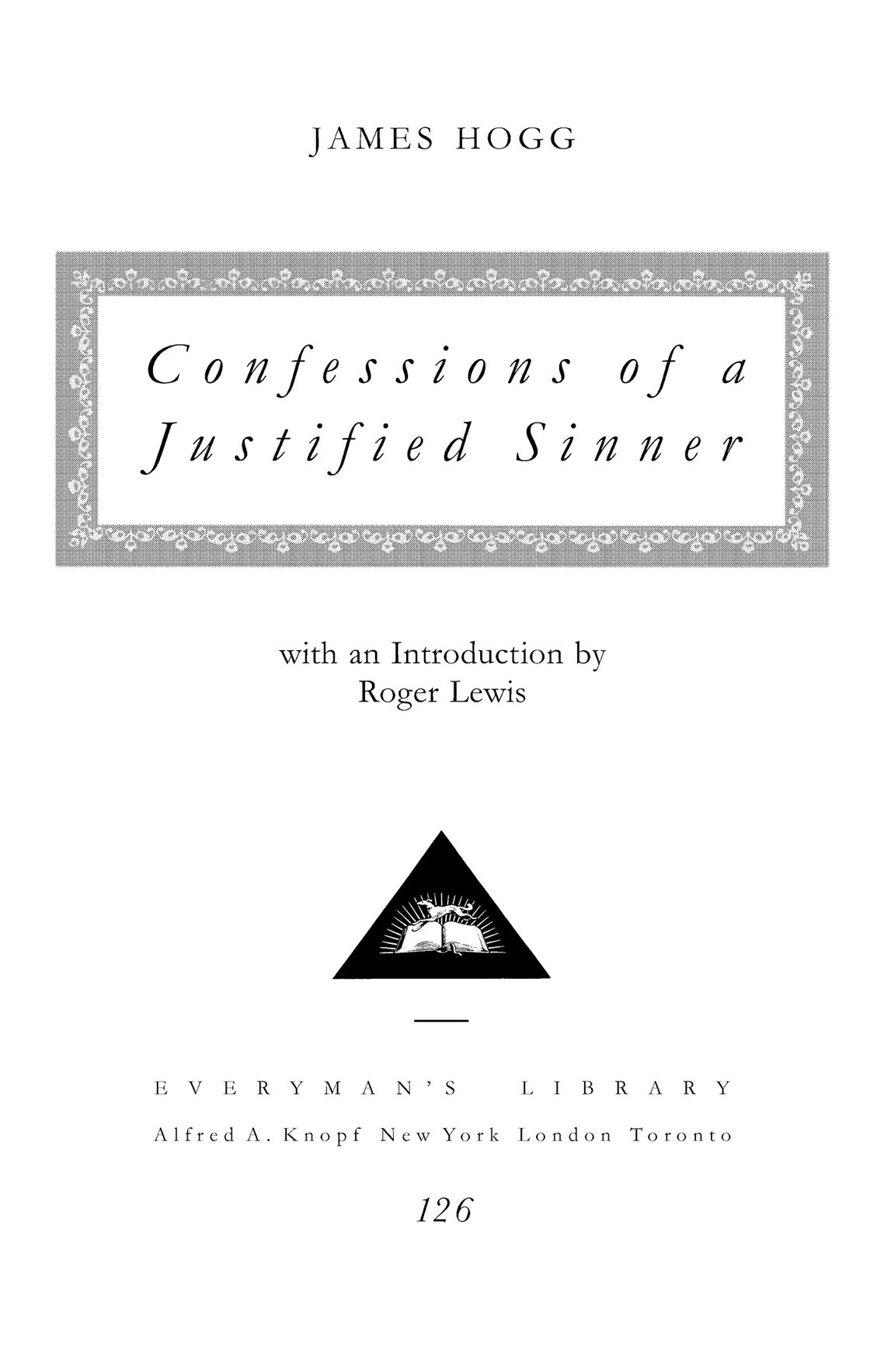Confessions of a Justified Sinner
• JAMES HOGG •
CONFESSIONS
OF A JUSTIFIED
SINNER
James Hogg (‘the Ettrick Shepherd’) was a poet, novelist, and farmer whose work was discovered by Sir Walter Scott and admired by writers as different as Wordsworth and Byron. His most famous book, CONFESSIONS OF A JUSTIFIED SINNER (1824), is striking in its use of Calvinist doctrine, demonology, and a highly modern psychological perception to tell the story of the criminal Colwan, deluded by occult forces into thinking he represents an instrument of divine justice and vengeance.




THIS IS A BORZOI BOOK
PUBLISHED BY ALFRED A. KNOPF
First included in Everyman’s Library, 1992
Introduction, Bibliography and Chronology Copyright © 1992 by
Everyman’s Library
Typography by Peter B. Willberg
Third printing (US)
All rights reserved under International and Pan-American Copyright
Conventions. Published in the United States by Alfred A. Knopf,
a division of Random House, Inc., New York, and simultaneously in
Canada by Random House of Canada Limited, Toronto. Distributed
by Random House, Inc., New York. Published in the United Kingdom
by Everyman’s Library, Northburgh House, 10 Northburgh Street,
London EC1V 0AT, and distributed by Random House (UK) Ltd.
US website: www.randomhouse.com/everymans
eBook ISBN: 978-0-375-71283-8
ISBN: 0-679-41732-X (US)
1-85715-126-7 (UK)
A CIP catalogue reference for this book is available from the British Library
Library of Congress Cataloging-in-Publication data
Hogg, James, 1770—1835.
Confessions of a justified sinner/James Hogg.
p. cm.—-(Everyman’s library)
ISBN 0-679-41732-X
I. Title.
PR4791.P7 1992 92-52926
823′.7—dc20 CIP
Book design by Barbara de Wilde and Carol Devine Carson
v3.1
CONTENTS
Cover
Title Page
Copyright
Introduction
Select Bibliography
Chronology
The Editor’s Narrative
The Private Memoirs and Confessions of a Justified Sinner
INTRODUCTION
Aptly, given its theme is that of doubles and doubling, Hogg’s is a twice-told tale. The first section, full of fights, town riots, slayings, cross-country escapes and who-knows-what hurly burly in a remote castle, and much else, is comic and rumbustious — the material is introduced as if for a newspaper, its readers avid for facts. The second section, by contrast, is intimate and terrifying — the drama lies not in any description of action, but in the relentless unfolding of Robert Wringhim Colwan’s meditations. The sinner’s confessions are a moment-to-moment diary of despair. We are suddenly on the other side of what it’s like to go insane. After that jaunty, enthralled opening (‘Great was the alarm and confusion that night in Edinburgh’), it’s like coming across a notebook left behind by Hamlet — for Robert, exactly like the Danish prince, has been urged on to commit a murder, coaxed and harried, by a ghost or goblin damned, with this result: ‘I was become a terror to myself … I wished myself non-existent.’
Part of Robert’s punishment is that he can’t even succeed in decomposing. As we discover in the journalistic coda (purportedly a letter in Blackwood’s Edinburgh Magazine), the suicide/fratricide’s corpse refuses to disappear — the too-solid flesh hasn’t melted in a hundred years. For, a century after the events of the narrative, when grave robbers are hunting for buckles and buttons, Robert’s skin and clothes have neither mouldered nor lost their bloom. A group of intrigued archaeologists and local historians exhume him yet again; they remark on his old-fashioned costume (the garters look ‘as if they had been newly tied’) and stamp on his head and nose with their iron heels. Then, what is this overlooked package near the body? Why, the sheets of the confession are discovered, immaculate in their slipcase. And isn’t that a pocket diary of additional material, blowing in the wind amongst the shards of skull? The gathered leaves become Hogg’s novel: ‘an original document of a most singular nature … I offer no remarks on it, and make as few additions to it, leaving every one to judge for himself’.
It was in the spirit of Romanticism for its authors to pretend they were merely editors. This way, they could distance themselves from the toxic core of their visions: it was all imagined by somebody else, in the long ago. Honestly. The Ancient Mariner’s anecdotes were passed on to Coleridge by a man on his way to a wedding who’d been importuned by a crank; Keats’ ideas were sprung on him by a nightingale, a copy of King Lear, that Greek vase. His texts had pretexts. The archetypal practitioner remains Thomas Chatterton, who died by his own hand in 1770, the year of Hogg’s birth. He passed off as medieval poet Thomas Rowley’s verses and plays of his own devising. He imitated the style of parish archives, their spelling and calligraphy, forging his own work on sooty paper with sepia inks. (The issue of imitation and translation, with its links to the psychopathology of the actor, is a subject to which we’ll return.) Chatterton reasoned that suicide was preferable to owning up as an original poet — he thus took his visions to the edge of dissociation, and beyond. His death, according to the survivors, was a martyrdom. Wordsworth wrote a poem (‘The heaven-eyed creature sleeps in earth’ etc.) and in our own time, Peter Ackroyd has used Chatterton as the eponym of a novel, to examine the moral implications of art’s deceits and many inventions.
In Scotland, the confidence trickery of scholarship was manifested by the Ossian controversy. Was Ossian an historically verifiable Gaelic bard of the third-century glens, or a late-eighteenth-century hoax? James Macpherson’s Fragments of Ancient Poetry Collected in the Highlands of Scotland (1760), which was apparently translated from the Erse, was, along with Fingal (1762), an ‘Ancient Epic Poem in Six Books’, scoffed at by Dr Johnson as a pile of ‘impudent forgeries’.
1 comment